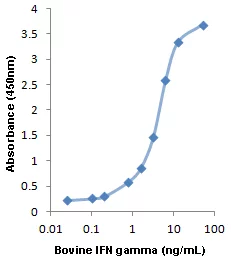Bovine Interferon Gamma ELISA Kit

- On This Page
- Overview

Typical calibration curve for bovine IFN gamma ELISA kit; detection range 0.025-50ng/ml.
Our Bovine Interferon Gamma ELISA Kit is convenient, flexible and easy to use. Its features include:
- Wide detection range covers physiological levels, disease states and in vitro stimulated cells
- Validated for serum, plasma and culture supernatant
- Quantitative results in one day
-
Includes ELISA plates and reagents for 480 tests
(5 x 96 wells)
Our research use assay uses two different mouse anti bovine interferon gamma (IFN-γ) monoclonal antibodies and recombinant bovine IFN-γ as a standard.
Measurement of IFN-γ plays an important role in evaluating the immune status of animals. IFN-γ is a secreted, pro-inflammatory cytokine, produced by lymphocytes in response to activation by specific antigens or mitogens.
It plays a critical part in immune and inflammatory responses, and has been identified as a potential therapeutic agent and marker for autoimmune and infectious diseases. Its measurement in cattle is particularly significant in relation to testing for bovine tuberculosis.
Bovine Interferon Gamma ELISA Kit
| Description | Target | Format | Clone | Applications | Citations | Code |
|---|
Bovine tuberculosis (TB) caused by Mycobacterium bovis is a worldwide animal health problem and remains a major threat to public health in countries where people live in close contact with their cattle and milk is not pasteurized. The incidence of TB in farmed cattle is increasing, signifying an urgent need for new and improved cattle vaccines and diagnostic tests.
A thorough understanding of the nature of immune responses to infection is crucial for the development of effective vaccines and diagnostic tests. In relation to bovine TB, the effect on the cow’s immune response of the cytokines IFN-γ, IL-2 and IL-4 are commonly investigated.
The quantitative determination of IFN-γ is accepted as a method for monitoring bovine tuberculosis as an ancillary test to confirm or negate the results of an intradermal skin test.
References
- Dean, GS et al. (2005). Minimum infective dose of Mycobacterium bovis in cattle. Infection and Immunity 73:6467-6471
- Doherty, R. et al. (2013). Epigenetic regulation of the innate immune response to LPS in bovine peripheral blood mononuclear cells (PBMC) Vet Immunol Immunopathol 154:102-110
- Rhodes, SG et al. (2000). Distinct response kinetics of gamma interferon and interleukin-4 in bovine tuberculosis. Infection and Immunity 68:5393-5400
- Rhodes, SG (2005). The cattle model of tuberculosis: studies in the natural host. Focus on tuberculosis research, Chapter 8, pp187-201 [ISBN: 1-59454-137-X].
Search BioMed Central for open access research articles on bovine tuberculosis and related topics


